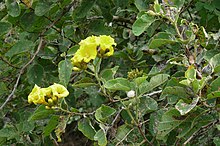Cordia lutea
| Cordia lutea | |
|---|---|
 |
|
| Growing in Santa Cruz, Galápagos | |
| Scientific classification | |
| Kingdom: | Plantae |
| Clade: | Angiosperms |
| Clade: | Eudicots |
| Clade: | Asterids |
| Order: | Boraginales |
| Family: | Boraginaceae |
| Genus: | Cordia |
| Species: | C. lutea |
| Binomial name | |
|
Cordia lutea Lam. |
|
| Synonyms | |
|
|
Cordia lutea, known as yellow cordia or in Spanish muyuyo, is a shrubby plant in the borage family (Boraginaceae), native to the Galápagos Islands, mainland Ecuador, Peru, and the Marquesas Islands in Polynesia. Common in the arid lowlands of the Galápagos, its relatively large yellow flowers make it easy to identify.
Cordia lutea grows as a shrub or a small tree, up to 8 m (26 ft) tall. The young branches are hairy. The undivided leaves are arranged alternately, and are 4–10 cm (1.6–3.9 in) long, ovate to round in shape, with very finely toothed margins. The upper side of the leaf is rough in texture but hairless; the lower side bears hairs.
The yellow flowers are arranged in cymes and are sweetly scented. The petals of each flower are fused together to form a trumpet shape, 2–4 cm (0.8–1.6 in) across at the mouth, which has five to eight lobes. Inside the flower there are five to eight stamens. After fertilization, a globular white fruit (a drupe) forms, 8–12 millimetres (0.3–0.5 in) across, containing from one to four seeds. The fruit has a fleshy pulp that is initially slimy when the fruit is opened, but becomes sticky on exposure.
In habitat on the edge of a beach, with Cryptocarpus pyriformis, Santa Fé, Galapágos
Flowers
Cordia lutea was first described scientifically in 1791 by the French botanist Jean-Baptiste Lamarck, with its origin said to be Peru. The specific epithet lutea means "yellow", more usually a deep yellow. In 1852, the Swedish botanist Nils Johan Andersson collected in the Galápagos Islands, and in 1855 described Varronia flava, now considered to be the same species as Cordia lutea.
...
Wikipedia
